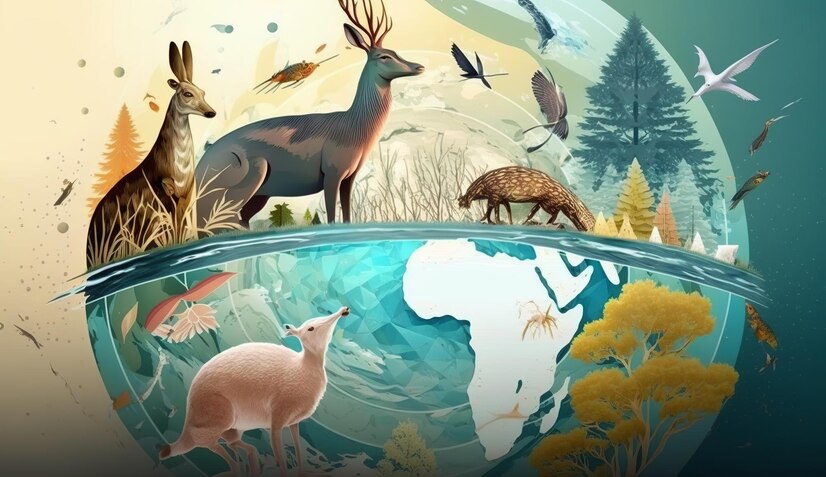The Importance Of Keystone Species In Ecosystems
5 Mins Read
Published on: 04 October 2023
Last Updated on: 09 October 2024

toc impalement
Ecosystems, which are intricate webs of life on our planet, are delicately balanced and interconnected. Within these ecosystems, certain species, like keystone species, play a disproportionately important role in maintaining their health and stability.
These species are the keystones that hold together the delicate fabric of life. In this article, we will explore the concept of keystone species, their characteristics, and their significant impact on the environment.
What Are Keystone Species?
Keystone species are those organisms that have a big impact on an ecosystem even though they are not very common. They are like the keystone in an arch, where if you remove one stone, the whole arch will collapse.
Keystone species can be animals, plants, or even bacteria. They can affect the ecosystem in many ways, such as by controlling the population of other species, by providing food and shelter for other species, or by helping to clean the environment.
If a keystone species is removed from an ecosystem, it can have a devastating impact on the entire ecosystem. For example, the removal of sea otters from the kelp forests of the Pacific Northwest caused the kelp forests to collapse, which in turn led to the decline of many other species that rely on the kelp forests for food and shelter.
Types Of Keystone Species
There are generally three types of keystone species:
- Mutualists.
- Ecosystem Engineers.
- Predators.
The Mutualists
The first variant of the keystone species is the mutualists. The bees are a perfect example of this very family. They interact with the plants. The interaction with teh plants is mutually beneficial.
They collect the primary food source from the nectar of the flowers. Thereafter, they enhance the growth of the plants, and they have a high potential for fertilization. Their interaction with nature is generally safe and mutually beneficial.
Ecosystem Engineers
The second variant of the keystone species is the ecosystem engineers. Beavers are a perfect example that typifies the class. They create their habitat, and after that, they modify it. To build their dams, they typically use dead trees. It encourages the species with new growth and development. Their dams also act to divert river flow, and they establish a rich wetland habitat. This is how they find their suitable habitat within the ecosystem.
The Predators
The most important of this group is the predators. They are the most important part of the entire ecosystem. Moreover, they impact the entire food chain. One of the most well-renowned keystone species is the gray wolf. Their population was depleting fast. But with the help of the government’s role, their fast depletion was restrained.
Examples Of Keystone Species
Let us look at some of the examples of the keystone species here in this section.
Sea Otters:
In the Pacific Northwest, sea otters are key players in the kelp forest ecosystem. By feeding on sea urchins, they prevent overgrazing of kelp. Without sea otters, sea urchin populations explode, leading to the decimation of kelp forests and the loss of numerous species that depend on them.
Wolves:
Wolves, often vilified in folklore, play a critical role in maintaining the balance of ecosystems like Yellowstone National Park. Their predation on herbivores like deer and elk prevents overgrazing of vegetation and promotes healthier plant communities.
Read Also: How Global Corporations Are Stepping Up Zero Plastic Efforts
How Might You Add Keystone Species To The Concept Map?
To understand “How Might You Add Keystone Species to the Concept Map?”, you can incorporate them into a concept map by highlighting their pivotal role in various ecosystems. Draw connections between keystone species and the effects of their presence or absence on biodiversity, trophic cascades, and ecosystem stability. Visualizing these relationships can provide a clearer picture of their significance.
Characteristics Of Keystone Species
Keystone species share several defining characteristics:
- Disproportionate Impact: Despite low population numbers, keystone species have a profound influence on ecosystem structure and function.
- Unique Roles: They occupy niches that are irreplaceable, performing functions that other species cannot replicate.
- Ecosystem Engineers: Some keystone species, like beavers, physically alter their habitats, creating opportunities for other species to thrive.
- Trophic Cascade Triggers: Their presence or absence can set off trophic cascades, where changes in one species’ population can affect multiple trophic levels.
Future Research And Outlook
The study of keystone species is an evolving field with exciting prospects:
- Technological Advances: Advancements in tracking and monitoring wildlife will allow for a more comprehensive understanding of keystone species’ behavior and interactions.
- Climate Change Implications: Research will increasingly focus on how keystone species respond to climate change and the subsequent effects on ecosystems.
- Conservation Strategies: As we recognize their importance, conservation efforts will target the protection and restoration of keystone species’ habitats.
Why Is Ecological Balance Important?
While we are discussing the types and features of the keystone species and their role in maintaining the ecosystem, it is important to understand ecosystem benefits as a whole. Yes, you got it right.
They are a part of the greater ecosystem, and there is no doubt about it. The food cycles and webs help maintain the overall ecological element and help create an ecosystem that provides all growth opportunities.
Let us try to provide an example to explicate the idea of a balanced ecosystem. A particular species of grassy weeds grow quite well. The growth further develops during the rainy seasons.
These particular grassy weeds are the preferred food for the goats. The goats feed on this grass, and they bear more offspring. The prevalence of goat firms in these areas is much higher compared to the others.
Hence, it could be understood that different ecosystem components are interdependent, and it helps strike a harmonious balance between the different species.
Conclusion
Keystone species are the unsung heroes of our ecosystems, holding the threads of life together. By recognizing their pivotal roles, we gain valuable insights into the intricate dance of nature.
As we continue to unravel the mysteries of these species and their significance, we are better equipped to preserve the delicate balance of our planet’s ecosystems for generations to come.
Read Also:


















Comments Are Closed For This Article